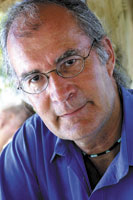Learning About Lighting
 When
I first started out in photography one of the foundations of the craft I set
out to learn was lighting. So I went out to my local camera store and bought
a set of metal reflectors with clamps, and, aided by the storekeeper, got me
a pair of blue, daylight photoflood bulbs and a few rolls of color film. Those
hot lights wilted subjects, both human and otherwise, and the harsh light they
threw presented quite a challenge. So I went back to the store and purchased
some flame-resistant, spun fiberglass diffusion material, clothespinned them
to the lights and learned about soft lighting. I studied the inverse square
rule, moved the lights all around my subjects and slowly got the hang of what
a key light and fill light could do. I even went out and bought some clamp-on
barn doors, background paper, a pole, and a set of 2x4 wedges, which I stuck
into the ceiling and floor of my apartment to convert the living room to a studio.
When
I first started out in photography one of the foundations of the craft I set
out to learn was lighting. So I went out to my local camera store and bought
a set of metal reflectors with clamps, and, aided by the storekeeper, got me
a pair of blue, daylight photoflood bulbs and a few rolls of color film. Those
hot lights wilted subjects, both human and otherwise, and the harsh light they
threw presented quite a challenge. So I went back to the store and purchased
some flame-resistant, spun fiberglass diffusion material, clothespinned them
to the lights and learned about soft lighting. I studied the inverse square
rule, moved the lights all around my subjects and slowly got the hang of what
a key light and fill light could do. I even went out and bought some clamp-on
barn doors, background paper, a pole, and a set of 2x4 wedges, which I stuck
into the ceiling and floor of my apartment to convert the living room to a studio.
I graduated to monolights and various types of strobes and slaves eventually,
but only after visiting a pro studio later in my education did I learn what
true photographic lighting could be and how it could transform a studio into
a playground of light. One of the best I saw at work was Ken Marcus, who worked
with snoots on tiny strobes, mini-continuous lights, and all the gobos, large
diffusion panels, and strategically placed mirrors one could imagine. I had
never seen so much lighting, and so many cords before.
The point of this meandering down memory lane is that all of us go through a
fairly steep learning curve to get a handle on lighting. These days you might
not need to go the reflector, photoflood route, what with the many affordable
strobe packages now available. But regardless of the gear you begin with you
might find, like me, that lights were only the beginning of the gear required.
Along with the source of illumination comes a raft of light modifiers, those
accessories that help you refine your lighting to match the subject at hand.
While digital has changed many things it has not eliminated the need to understand
how to work with lighting. Regardless of your skill with Photoshop or other
image-editing programs, getting the light right when you make the picture will
make your postproduction work so much easier. Really mess up and not even the
most skillful Photoshop operator will be able to save the shoot. Deliver a well-balanced
and properly exposed shot and your software will help you refine the subject
even more. If there's anything I've learned from my lighting education
it is that photographic lighting is all about enhancement and balance. While
there may be times when you want to create special effects or extreme high contrast,
for the most part your lighting aim should be to emulate the one true source
of illumination--the sun--and to make the subject, and not the obvious
use of artificial light, the main attraction.
All of us have to go through a learning curve with lighting. It's a subtle
art, one learned from experience and having secrets shared and revealed by our
peers. I'm proud to say that each issue of Shutterbug contains its fair
share of lighting tips, techniques, and product reviews, with masters such as
Monte Zucker, Jay Abend, Jack Neubart, Joe Farace, and Steve Bedell keeping
us all up to speed. Happily, four of our lighting craftsmen are with us in this,
our Lighting issue. In addition, we've got Joseph Dickerson, a master
of lighting in the field, helping us to read the light with his survey on spot
meters.
Another great resource you can use to learn more about lighting is our web page.
If you go to our homepage at www.shutterbug.com and type Lighting into the Search
field you'll find over 500 archived articles on everything from lighting
techniques to product reviews. That's more than a complete course onto
itself!

































